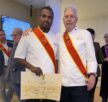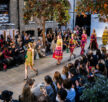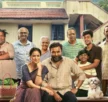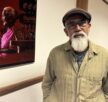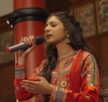

Pirashanna Thevarajah on The Dewarists
- 30th November 2012
- POST IN :MUSIC
Television series "The Dewarists" first aired in India in 2011, and by the end of the first episode, music-lovers were hooked. The show is partly a music documentary and partly a travelogue, featuring incredibly-talented musicians coming together to create original tracks in spectaular locations across the world. Viewers join the music-making process from the beginning, getting a taste of what it’s like to create a song from start to finish.
Season Two of The Dewarists kicked off earlier this year and the fifth episode in the series is a special one, as one of the featured musicians is percussionist Pirashanna Thevarajah, from London! With sitar player Anoushka Shankar – daughter of world-renowned sitar player Pandit Ravi Shankar – at the helm, the episode entitled "The Gypsy" aired last week. Along with Shehnai player Sanjeev Shankar, Anoushka and Pirashanna work to create the track which takes classical Indian music and gives it a modern twist.
Like a lot of youngsters, Pirashanna got into Mridangam because his parents had insisted he learnt a Carnatic art form. As a result, he didn’t enjoy the classes when he first started, saying "I didn’t look forward to going to Mridangam class in the first few months. I think part of the reason was that my brother had been learning Mridangam before me. So when we went to classes, he’d be learning the ‘cool’ stuff while I was learning the basic lessons. But I soon started to catch up, and I think that is purely because I was (and still am) blessed with a fantastic Guru at the Bharatiya Vidya Bhavan – Sri M Balachandar. It is definitely because of him that I began to like it."
Pirashanna has been working with Anoushka Shankar for almost a decade, and despite the major differences between North and South Indian classical music, the two understand each other very well, musically. But when he started, was it difficult to adapt his Southern style to fit North Indian melodies? "Not really…soon after I started learning Mridangam, I took a keen interest in listening to a lot of percussion, including a lot of Tabla – mostly Zakir Hussain. So I guess I got used to that style of music, even though I hadn’t had any formal training in Hindustani music," says Pirashanna. "Also, I was part of SAMYO (UK’s first South Asian Music Youth Orchestra) for a few years, and we collaborated with a lot of Hindustani musicians. So all of that has definitely helped in my understanding of Hindustani music."
The track created by the trio is a fusion of a number of musical styles – something that some die-hard Carnatic or Hindustani listeners may not be a fan of. As someone who has spent almost all his life training in Indian classical music, though, Pirashanna is in full support of the growing number of artists who work to put a modern spin on the classical art forms. In fact, he feels that this could be a good way to get people to pay more attention to Carnatic music!
"When one mentions Indian music, usually the first thing that comes to mind is either a Sitar or Tabla. I think it is high time that instruments like the Veena and Mridangam became just as popular! That’s why I think it is important to find new of ways of presenting Carnatic music, so that it can appeal to a wider audience."
But is it possible to mould a musical genre that was developed thousands of years ago in such a way? "Definitely," asserts the musician. "There are so many raagas and talas in Carnatic music that there is always some way of integrating it with another style of music. And in order to do something new, I feel that we, as Carnatic musicians, should be open to experimenting with and appreciating other genres of music."
Filmed in New Delhi, the episode itself (which can be viewed in its entirety by clicking here) begins with an introduction to each of the three musicians. Then we follow them on their journey around the city as they draw inspiration from their surroundings before we get a look into their studio sessions as they create the track "The Gypsy".
"I had a blast filming this episode. I have known Anoushka and Sanjeev for a very long time, we always have a lot of fun when working or performing together. This was no exception, recording and putting together ‘The Gypsy’ was a lot of fun. The Dewarist team were just great! I loved the place they took me to for my interview, Agrasen Ki Baoli…I never knew such a place even existed in Delhi."
Check out the video for "The Gypsy" below. What do you think of the track?
- Previous Post
Throwback Thursday #8


